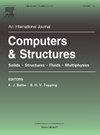An approximate method for natural frequency analysis of variable-pitch vertical axis wind turbine blades
IF 4.4
2区 工程技术
Q1 COMPUTER SCIENCE, INTERDISCIPLINARY APPLICATIONS
引用次数: 0
Abstract
This study aims to enhance the operational stability and efficiency of flexible blades in variable-pitch vertical-axis wind turbines, providing significant engineering applications. Currently, research on blade dynamic behavior often simplifies blades to slender beam models, yet this approach has limitations in analyzing blades of small and medium-sized vertical-axis wind turbines, particularly for variable-pitch vertical-axis wind turbines, where the blades do not always meet the slender beam assumption. To address this, the study constructs a variable-pitch dynamic model based on the Euler-Bernoulli and Timoshenko beam theories. Using an assumed mode method combined with a multi-scale approach, the dynamic characteristics of the blades under different models are systematically analyzed, and the impact of variable pitch on frequency is further explored. Results indicate that the Timoshenko beam model demonstrates higher accuracy in predicting high-order modal frequencies, especially under larger pitch amplitudes, allowing for a more precise description of blade flap responses. Additionally, pitch amplitude significantly affects the natural frequency, whereas the effects of pitch frequency and phase are relatively minor. This research provides a theoretical foundation for optimizing variable-pitch vertical-axis wind turbines blade structural design and offers crucial technical guidance for enhancing stability and efficiency in long-term operation.
变节距垂直轴风力机叶片固有频率的近似分析方法
本研究旨在提高变节距垂直轴风力机柔性叶片的运行稳定性和效率,具有重要的工程应用价值。目前,对叶片动力特性的研究往往将叶片简化为细长梁模型,但这种方法在分析中小型垂直轴风力机叶片时存在局限性,特别是对于变桨距垂直轴风力机,叶片并不总是满足细长梁假设。为了解决这一问题,本研究基于Euler-Bernoulli和Timoshenko梁理论构建了变间距动力模型。采用假设模态法结合多尺度方法,系统分析了不同模型下叶片的动态特性,并进一步探讨了变桨距对频率的影响。结果表明,Timoshenko梁模型在预测高阶模态频率方面具有更高的精度,特别是在较大的俯仰幅值下,可以更精确地描述叶片襟翼响应。此外,基音幅值对固有频率的影响显著,而基音频率和相位的影响相对较小。该研究为变节距垂直轴风力机叶片结构优化设计提供了理论基础,为提高长期运行的稳定性和效率提供了重要的技术指导。
本文章由计算机程序翻译,如有差异,请以英文原文为准。
求助全文
约1分钟内获得全文
求助全文
来源期刊

Computers & Structures
工程技术-工程:土木
CiteScore
8.80
自引率
6.40%
发文量
122
审稿时长
33 days
期刊介绍:
Computers & Structures publishes advances in the development and use of computational methods for the solution of problems in engineering and the sciences. The range of appropriate contributions is wide, and includes papers on establishing appropriate mathematical models and their numerical solution in all areas of mechanics. The journal also includes articles that present a substantial review of a field in the topics of the journal.
 求助内容:
求助内容: 应助结果提醒方式:
应助结果提醒方式:


